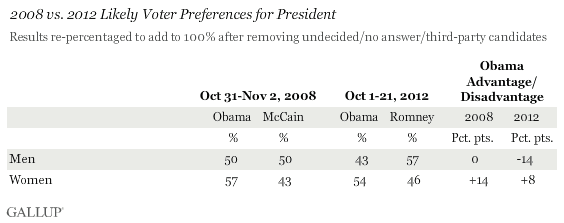PRINCETON, NJ -- Despite the great attention paid to the importance of the women's vote in the 2012 election, there has been a larger change in men's than in women's preferences compared with 2008. Barack Obama's support is down seven percentage points among men versus three points among women. In Gallup's latest 21-day rolling average of likely voter preferences, based on interviewing conducted Oct. 1-21, Romney leads Obama by 14 points among men, whereas Obama and John McCain were tied among men in Gallup's final pre-election estimate in 2008. Obama currently leads Romney by eight percentage points among women, whereas he led McCain by 14 among women in 2008.

Overall, the gender gap in support for the two candidates is somewhat wider than Gallup's estimate of where it was just before the 2008 election - at 22 points, compared with 14 points. Obama has lost support among both gender groups compared with 2008, when he won the popular vote by seven points over McCain, but the results show that he has lost more among men than among women.
Romney More in Tune With Men's Issues?
Gallup's recent analysis shows that there are no highly specific "men's" issues when men in swing states were asked "What do you consider the most important issue for men in this election?" The top five responses were jobs, the economy, the deficit, healthcare, and taxes. These are the types of issues on which Romney does best on a relative basis vis à vis Obama. Romney does particularly well, as one example, on the deficit. Thus, Romney's stronger position among men may result from his perceived strength on issues that are specifically most important to men.
The same swing-state survey asked American women to name most important women's issues in this election, and the results showed "abortion" and "equal rights" to be in the top five, along with jobs, healthcare, and the economy. These results give some indication of why Obama has been able to hold on, proportionately, to the women's vote. Recent national polling among registered voters indicates that Obama is given the clear edge, 53% to 37%, on government policies relating to birth control, and polling in late September shows that he led Romney on "social issues such as gay marriage and abortion" by 26 points.
Still, an analysis of women's responses to a separate question asking about the most important problem facing the nation -- without specific mention of "women's issues" -- shows that women's responses do not differ substantively from men's in most instances. Women are, however, less likely to mention the deficit, a Romney strength, and more likely to mention healthcare, a relative Obama strength, but the differences are not large.
Implications
At this point, Romney's slight edge in the overall likely voter preferences reflects the fact that he leads among men by a wider margin than Obama leads among women. Obama's support among women is down from the support he received from them in 2008, but not to the same extent as the increase in men's support for Romney compared with men's support for John McCain in 2008. This growing gender gap may reflect Romney's relative strength on issues relating to the economy, jobs, and the deficit. Of course, voter preferences, both overall and within gender groups, may change significantly between now and Election Day, Nov. 6.
Track every angle of the presidential race on Gallup.com's Election 2012 page.
Survey Methods
Results are based on telephone interviews conducted as part of Gallup Daily tracking Oct. 1-21, 2012, with a random sample of 8,203 likely voters, aged 18 and older, living in all 50 U.S. states and the District of Columbia.
For results based on voters, one can say with 95% confidence that the maximum margin of sampling error is ±1 percentage point.
Interviews are conducted with respondents on landline telephones and cellular phones, with interviews conducted in Spanish for respondents who are primarily Spanish-speaking. Each sample includes a minimum quota of 400 cell phone respondents and 600 landline respondents per 1,000 national adults, with additional minimum quotas among landline respondents by region. Landline telephone numbers are chosen at random among listed telephone numbers. Cell phone numbers are selected using random-digit-dial methods. Landline respondents are chosen at random within each household on the basis of which member had the most recent birthday.
Samples are weighted by gender, age, race, Hispanic ethnicity, education, region, adults in the household, and phone status (cell phone only/landline only/both, cell phone mostly, and having an unlisted landline number). Demographic weighting targets are based on the March 2011 Current Population Survey figures for the aged 18 and older non-institutionalized population living in U.S. telephone households. All reported margins of sampling error include the computed design effects for weighting and sample design.
In addition to sampling error, question wording and practical difficulties in conducting surveys can introduce error or bias into the findings of public opinion polls.
For more details on Gallup's polling methodology, visit www.gallup.com.
